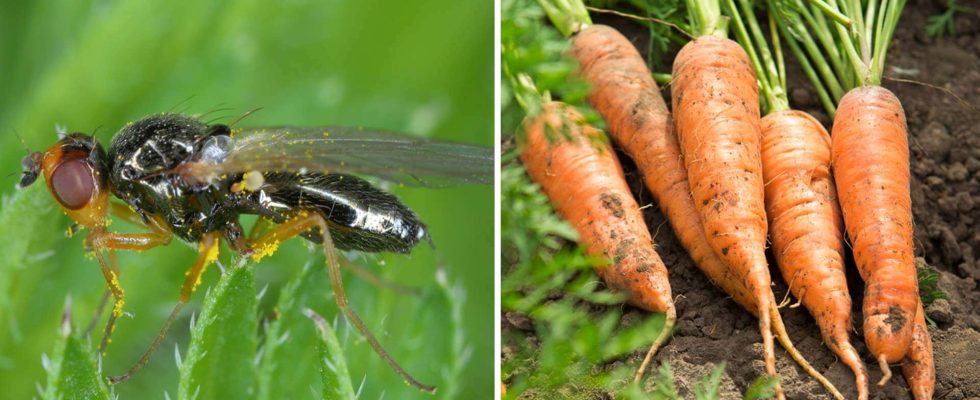Insects that cause damage
The carrot is the favorite root of the larvae of this insect which can also attack parsley, parsnip, celery, chervil or fennel. Damage to the core can take various forms depending on the state of vegetation. On young plants, root growth may be arrested, leaves turn yellow and death follows; on older plants, the maggots dig more or less superficial galleries below the collar; cracks then form and rot sets in and worsens during storage.
What are the favorable conditions for the development of the carrot fly?
The carrot fly thrives especially in moist soils rich in organic matter. It is also attracted by the smell of injured roots when weeding or hoeing. It prefers shaded areas sheltered from the wind, where it can fly more easily. It is most active at temperatures between 10°C and 25°Cand avoid periods of high heat or frost.
The lifestyle of the carrot fly
The insect spends the bad season in the form of a larva or pupa (a sort of chrysalis). The appearance of flies begins in April and continues over the following months.
These lay their eggs on the ground, near plants. After hatching, the larvae move towards the roots, which they dig with galleries. After about a month, the maggots transform into pupae from which new adults will emerge, a few days later. Subsequently, depending on the climate, we count in the year two, three and sometimes four generations. The larvae and pupae of the last generation will overwinter, posing a threat to the following year’s crop.
How to get rid of it?
Killing flies is difficult due to the spread of exits. We are mainly trying to create a deadly zone around the roots for the larvae, which is obtained by spreading insecticide in granules (Légusol 5G Clause, Soluvil Vilmorin, etc.) in the row during sowing. On the other hand, late sowing in June makes it possible to avoid the majority of first generation fly eggs.
What are the alternative methods to combat carrot fly?
There are several alternative methods to combat carrot fly, without resorting to chemical insecticides, including:
- Practice crop rotation, avoiding growing plants from the same family (umbellifers) on the same location for at least three years ;
- Pair carrots with plants that resprout or mask the odor of the roots, such as garlic, onion, leek, mint, rosemary or sage ;
- Cover the rows of carrots with anti-insect veilwell stretched and buried on the edges, from sowing or transplanting;
- Install pheromone trapswhich attract and capture male carrot flies, thereby reducing reproduction;
- Drop auxiliariessuch as nematodes or trichogramma, which parasitize or devour the larvae of the carrot fly.

